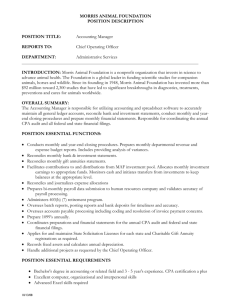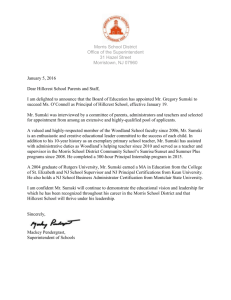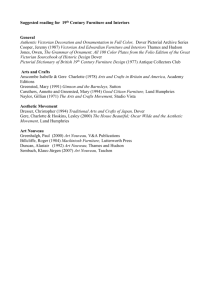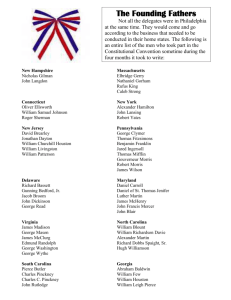Arts and Crafts Influence on Education
advertisement
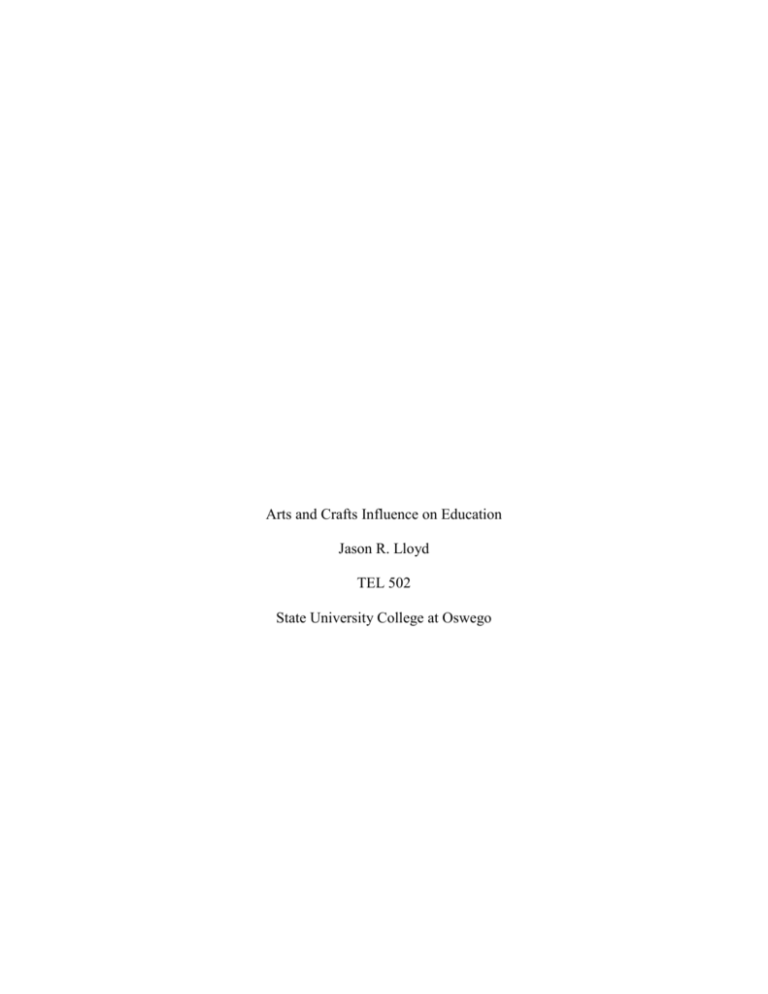
Arts and Crafts Influence on Education Jason R. Lloyd TEL 502 State University College at Oswego Introduction The arts and crafts influence on education has help develop the technology field into a historical field of chaos. In order to understand technology education today, we need to first understand the history of the influence of the Arts and Crafts Movement and second social and economic, conditions of the late 19th century. The focus of this paper is to clarify the origin of the Arts and Crafts Movement and the personal interpretation of how it shaped the educational field of today. Historical Background The official date of incorporation of the Arts and Crafts Movement in America is 1897, but that era started long before this official date. The movement was the start of a transition from the traditional manufactured Victorian designs to handcrafted simple craftsmanship. This new movement originated in England around 1888, as the Industrial Revolution was eliminating craftsmanship to quantity; hand tools were replaced by machines (Gomez, 2001). The industrialization was eliminating the skills and trades that had been handed down for generations among craftsman and women. The Arts and Crafts Movement proved to be widely influential, popular, and long lasting; spreading across the Atlantic to Boston to be established in the states starting in 1897 after a showing. A small group of architects, educators, craftspeople, and collectors organized the first crafts exhibition held in this country (Unknown 1, 2003). The show promoted excellence in design, technical mastery, and usefulness in ever day life. Arts and crafts relied on the past medieval designs, simple and practical, straight lines and solid craftsmanship for longevity. The Gothic revival of the first half of the 19th century was an 1 important influence of the arts and crafts movement by revisiting the influences of the Middle Ages architecture and cathedrals. It also revived the skills and traditional materials used by the medieval craftsman. William Morris As far as the founder of the arts and crafts movement, William Morris (1834-1896) has the strongest historical background. Morris came from an affluent family of the time in Walthamstow, England; He was the third out of nine children of William and Emma Shelton Morris. Morris led a happy, but spoiled childhood. He enjoyed to forests, birds, gardens, and flowers which led to his reoccurring topics in his art, poetry, and infatuation with medieval times (Cody, 1987). In 1847, Morris’s father died and a year later William entered Marlborough College at the age of 14. Morris left the college in 1851 to return home. In 1853, Morris entered Exeter College with the hopes of becoming a member of the clergy. With the reason why he wanted to become clergy was of his attraction to medieval ideals such as chivalry and communal life. In 1855 Morris was old enough to receive his first annual inheritance of 900 pounds, which roughly figures out to be over 30 thousand American dollars currently. With the money backing him, he left Oxford at the end of the year to become an artist. After a brief apprenticeship in 1856, Morris abandoned architecture to study art. Three years later at the age of twenty five, in 1859, he married a woman named Jane, who was 18. They had two daughters Jenny and May within the first few years of marriage. 2 In 1870 Morris was a vocal politician and started many organizations. His main concerns where poverty, unemployment, lost skills, and the growing gap between upper and lower classes which he blamed the Industrial Revolution within the Victorian Society. During the year of 1877, Morris founded The Society for the Protection of Ancient Buildings, which makes him the earliest environmentalist and preservationist (Cody, 1987). Morris was a poet, politician, artist, craftsman, designer, and a printer. One of his first joint business endeavors was with a partnership he funded of Morris, Marshall, Faulkner and Company that supplied wallpaper, furniture covers, and “useful embroideries” in 1873 (Unknown 2, 2001). Prior to this in 1861, Morris formed a partnership with some painters to produce manufactured decorations of carvings, metalwork, stained glass, and carpeting noted for their fine craftsmanship which they thought to reinvest everyday objects with these qualities (Gomez, 2001). A small business of needle work actually boosted the educational fields of skilled trades. Morris, with the help of his wife and daughters, started embroidery kits hand drawn on linen to be needled with silks and wools. His wife and daughters often started the corners as a way to guide the consumers, they called this business “gardening with silk and gold thread”. This needle work invited Morris to the Royal School of Needlework in London, which lead to his work traveling overseas to the New York Society for Decorative Arts, Newcomb College, Kensington School of Needlework, and the Massachusetts Normal Arts School (Unknown 3, 1998). Morris seemed to give a rebirth to medieval arts in a new era. 3 Charles Locke Eastlake Charles Locke Eastlake (1836-1906) was a predecessor to Morris. Eastlake was an architect, writer, and furniture designer who produced a revolution of design. He reintroduced hand craftsmanship, honest construction and time honored finishing techniques. Eastlake designs often boasted handcrafted solid woods and visible rectangular jointers. He condemned the use of stains and varnishes to disguise expensive woods; preferring instead to use oils and natural colored finishes. “The present system of French polishing, or literally varnishing furniture is destructive of all artistic effect in its appearance, because the surface of the wood thus lacquered can never change its color, or acquire that rich hue which is one the charms of old cabinet work” (Bienestock, 1998). Eastlake authored a book entitled Hints on Household Taste which Morris found particularly inspiring. Charles Locke Eastlake’s reforming ideas have had many names over the years, new Renaissance style, neo-medieval, plank construction, or even Art furniture (Unknown 4, 2000). Eastlakes ideas inspired an entire revolution from the Victorian style , however it was Morris who received credit. Perhaps Morris carried this title because he had the money to bring the style to the consumer. The Stickley’s Leopold and Gustav The common misconception of the Arts and Crafts Movement is the Stickleys. The Stickley brothers, where actually promoters of the Arts and Crafts designs. Gustav visited England in the late 1890’s, when he returned he founded the United Crafts in order to promote the principles established by Morris (Unknown 2, 2001). “Both the artistic and the socialistic sense…to substitute the luxury of taste for the costliness; to 4 teach that beauty does not imply elaboration or ornament; to employ only those forms and materials which make for simplicity, individuality and the dignity of effect” (Stickley 1901). Stickley designs where simple compared to the over decorated mass produced furniture for the middle class. The designs fulfilled its mission of usefulness, well proportioned, simple and honest constructed furniture (Unknown 2, 2001). The Stickleys made the Arts and Crafts design well known through mass marketing, publicity, targeted American’s the American desire for change in design, Stickley based their designs on Morris’s and Eastlake’s philosophies. Stickley started furniture in 1901 with the “craftsman” style in which critics of the time stated how it resembles Arts and Crafts and the west coast mission style. Leopold Stickley in one of his books by describing how his employees worked down played the Arts and Crafts Movement, … “earliest settlers equipped with only simple tools, their one great wealth was the skill of their hands. Schooled in the art of building sturdy, long lasting structures by joining separate pieces of wood together with interlocking joints, they quickly erected shelter against the elements, and furnished them with rude, but surprisingly well proportioned benches, beds, and chairs” (Stickley, 1950). He made it sound as if the settlers of this country worked for him and only desire function not beauty in design. Mission Mission is yet another style people associate with Stickley. However they only adapted the style. The mission style actually originated in Mexico by the native Indians. The mission style was first mass produced in 1890’s by Joseph McHugh, a manufacture of furniture for the west coast. Mission furniture is characterized by being solid, simple, 5 weathered or fumed oak, straight lines, mortise and tenon joinery and having dowels to lock joints (Unknown 4, 2000). Connections The true father of the Arts and Crafts Movement would have been the craftspeople of the medieval times, but because that era was gone Eastlake was the first known to evoke ideas of simpler designs from the Victorians ornate style. Eastlake enjoyed the natural beauty of wood. Morris read Eastlake and had the financial backing to create what is today known as the Arts and Crafts Movement. Morris revitalized the skill crafts which the Industrial Revolution eliminated. Stickley followed Morris’s ideas to a limited point. Ironically Morris was against the Industrial Revolution and mass production, Stickley founded his factory on mass production, using immigrants of the turn of the century to work in a factory not local craftsman as implied in his book. Originally the wood was fumed to gain the old cabinet patina that Eastlake boasted of, however today OSHA deems this process unsafe. To this day L&JG Stickley Company/EJ Audi Company still produces Morris furniture, Eastlake reproductions, and other designs by Harvey Ellis. Ellis was an employee of Stickley who designed furnishings he never benefited from the profits of his designs; he died a pulpier. Stickley also to this day uses a large number of immigrants employees. The company receives government money to pay a portion of the immigrants wages. They have also begun to manufacture some of the pieces now out of plywood. The handcrafted furniture of the movement is replaced by computers and automated machines. Stickley has now evolved into a company of mass production not of hand crafted pieces which was Morris and Eastlakes vision. Stickley produces 6 hundreds on thousands of furniture each day, they actually measure their productivity on dollars not pieces. Carvings and inlays are sent outside the state to be mass produced by a computer. Leopold said, “ From the earliest dawn of history, artist and creative workers have identified the works of their hands and brains by some distinctive symbol or signature. These marks have come to be a sign of genuine value, a guarantee of authenticity, a certificate of craftsmanship recognized by the collectors and neophyte alike.” The logo is part of production not a finial seal of approval, “…because its easier to do before it is put together,” my supervisor once told me. During my four years at Stickley, I have seen a lot, such as cherry plywood not solid cherry, from a company that advertises solid wood, hot glue to hold decorative pieces together, and greed to increase production to make more money for the owner while still averaging less than ten dollars and hour in 1999 for skilled craftspeople. Conclusion The influence of the Arts and Crafts Movement on the educational system, on the surface appears to be promoting the lost skills and trades of the centuries past, by reinforcing the ideas of honesty, practicality, and craftsmanship. W.R. Lethaby wrote early in the 20th century “ if the thing is not worth doing it can hardly be a work of art, however well it may be done. A thing worth doing which is ill done is hardly a thing at all” (Burrows, 2003). Under the surface the Arts and Crafts Movement has paralleled the educational system. The needs of the students has been changed based on political powers over the last century, although math has not changed for centuries the curriculum has, the same for Social Studies, Sciences, Art and Music, even Physical Education. To summarize a 7 statement by Dr. William Waite, Really good industrial arts programs where actually teaching technology already. Technology educators teach basic problem solving skills needed and how they are applied in everyday life, what the title of our curriculum is irrelevant, it changes only in the way in which we present material. Regardless of the time period, whether it be medieval period or the 21st century, usefulness and practical application has been the focus. Just as the Arts and Crafts Movement started with the basic belief in practical usefulness design so has technology education. They both survived social and political changes such as the Victorian era, Industrial Revolution, computerized reproductions, business owners greed, and various commissioners of education. Today technology education is entering a new phase, Project Lead the Way, which emphasizes model theory over hands on production. The bottom line however reflects medieval Europe’s usefulness and practical application regardless of the title of the education program. 8 Bibliography Stickley, L (1950).The Story of a Developing Furniture Style. Fayetteville, NY L.&J.G. Stickley Inc. Gomez, A. (2001). Manual Arts Movement. Retrieved October 1, 2003. www.imagine101.com/manual.htm Unknown (2003). Society of Arts and Crafts. Retrieved October 1, 2003. www.societyofcrafts.org/about.asp Unknown (2003). Retro Publishing. Retrieved October 1, 2003. www.retroactive.com/artsncrafts/garcia1.html Unknown (1998). The Arts and Crafts Movement in America. Retrieved October 1, 2003. www.white-works.com/artscrafts.htm Unknown (2002). The Arts and Crafts Movement in Ditchling. Retrieved Oct. 1, 2003. www.ditchling-museum.com/arts_crafts_intro.htm Bienenstock, R.(1998). The History of Furniture Styles. Southern Pines, NC Towse Publishing Company J.R. Burrows & Company, (2003). Arts & Crafts Movement Furniture for the Idaho Building at the Columbian Exposition, Chicago,1893. Retrieved October 1, 2003 www.burrows.com/founders/furniture.html Cody, D. (1987) The Victorian Web. Retrieved October 1, 2003 www.victorianweb.org/authors/morris/wmsocialm.html 9

